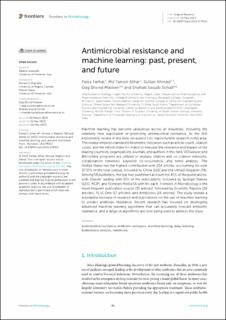| dc.contributor.author | Farhat, Faiza | |
| dc.contributor.author | Athar, Md Tanwir | |
| dc.contributor.author | Ahmad, Sultan | |
| dc.contributor.author | Madsen, Dag Øivind | |
| dc.contributor.author | Sohail, Shahab Saquib | |
| dc.date.accessioned | 2023-10-24T09:11:45Z | |
| dc.date.available | 2023-10-24T09:11:45Z | |
| dc.date.created | 2023-06-29T13:06:53Z | |
| dc.date.issued | 2023 | |
| dc.identifier.citation | Farhat, F., Athar, M. T., Ahmad, S., Madsen, D. Ø. & Sohail, S. S. (2023). Antimicrobial resistance and machine learning: past, present, and future. Frontiers in Microbiology, 14, Artikkel 1179312. | en_US |
| dc.identifier.issn | 1664-302X | |
| dc.identifier.uri | https://hdl.handle.net/11250/3098293 | |
| dc.description.abstract | Machine learning has become ubiquitous across all industries, including the relatively new application of predicting antimicrobial resistance. As the first bibliometric review in this field, we expect it to inspire further research in this area. The review employs standard bibliometric indicators such as article count, citation count, and the Hirsch index (H-index) to evaluate the relevance and impact of the leading countries, organizations, journals, and authors in this field. VOSviewer and Biblioshiny programs are utilized to analyze citation and co-citation networks, collaboration networks, keyword co-occurrence, and trend analysis. The United States has the highest contribution with 254 articles, accounting for over 37.57% of the total corpus, followed by China (103) and the United Kingdom (78). Among 58 publishers, the top four publishers account for 45% of the publications, with Elsevier leading with 15% of the publications, followed by Springer Nature (12%), MDPI, and Frontiers Media SA with 9% each. Frontiers in Microbiology is the most frequent publication source (33 articles), followed by Scientific Reports (29 articles), PLoS One (17 articles), and Antibiotics (16 articles). The study reveals a substantial increase in research and publications on the use of machine learning to predict antibiotic resistance. Recent research has focused on developing advanced machine learning algorithms that can accurately forecast antibiotic resistance, and a range of algorithms are now being used to address this issue. | en_US |
| dc.language.iso | eng | en_US |
| dc.rights | Navngivelse 4.0 Internasjonal | * |
| dc.rights.uri | http://creativecommons.org/licenses/by/4.0/deed.no | * |
| dc.title | Antimicrobial resistance and machine learning: past, present, and future | en_US |
| dc.type | Peer reviewed | en_US |
| dc.type | Journal article | en_US |
| dc.description.version | publishedVersion | en_US |
| dc.rights.holder | © 2023 Farhat, Athar, Ahmad, Madsen and Sohail. | en_US |
| dc.source.pagenumber | 14 | en_US |
| dc.source.volume | 14 | en_US |
| dc.source.journal | Frontiers in Microbiology | en_US |
| dc.identifier.doi | https://doi.org/10.3389/fmicb.2023.1179312 | |
| dc.identifier.cristin | 2159453 | |
| dc.source.articlenumber | 1179312 | en_US |
| cristin.ispublished | true | |
| cristin.fulltext | original | |
| cristin.qualitycode | 2 | |

